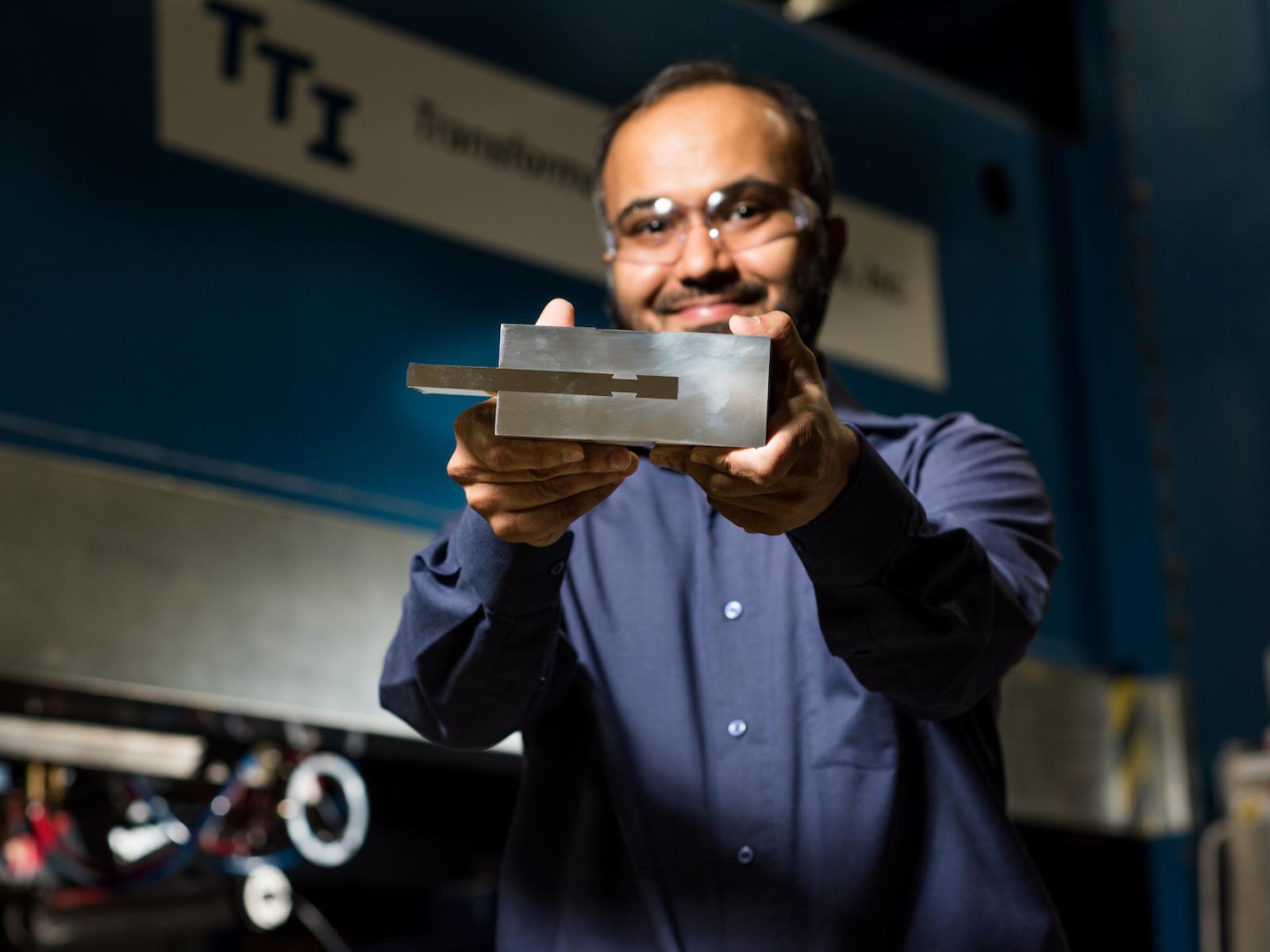10 Research Accomplishments at Pacific Northwest National Laboratory in 2018
PNNL is advancing scientific frontiers and addressing challenges in energy, the environment and national security. So, in no particular order, here are PNNL's top 10 research accomplishments of 2018

Researchers at Pacific Northwest National Laboratory have developed and successfully tested a novel process-called Friction Stir Dovetailing-that joins thick plates of aluminum to steel. The new process will be used to make lighter-weight military vehicles that are more agile and fuel efficient.
Photo courtesy of Andrea Starr, Pacific Northwest National Laboratory.
As the year draws to a close, top-10 lists of all kinds appear — from box office hits to bestselling novels, top products and baby names.
In that spirit, I reflected on the extraordinary accomplishments of the scientists and engineers at the Department of Energy's Pacific Northwest National Laboratory over the past year.
While difficult to select only 10, these highlights demonstrate how PNNL is advancing scientific frontiers and addressing challenges in energy, the environment and national security. So, in no particular order, here are PNNL's top 10 research accomplishments of 2018:
- Flying high on low-carbon jet fuel: A 747 that flew from Orlando to London in October was powered by jet fuel produced in part from carbon-rich waste gases, thanks to a process developed by PNNL and industry partner LanzaTech. In this process, bacteria were used to convert carbon monoxide into ethanol. Then, a specialized PNNL catalyst upgraded the ethanol to paraffinic kerosene, a cleaner-burning fuel that is blended with conventional jet fuel.
- Looking for dark matter: PNNL and international collaborators created a device with the sensitivity to "hear" the telltale signs of axions — yet-to-be discovered sub-atomic particles of dark matter — and distinguish them from electromagnetic "noise" that makes them difficult to identify. Detecting dark matter could help shed light on the origin of the universe.
- Protecting against cyberattacks: Two PNNL cybersecurity technologies made R&D magazine's 2018 list of top 100 scientific breakthroughs. DCAT protects the electrical grid by constantly analyzing changing conditions to quickly identify vulnerabilities and suggest actions that power operators could take to avoid cascading outages. StreamWorks helps cyber analysts cut through the clutter of big data to detect patterns of sophisticated cyberattacks.
- Collecting uranium from seawater: Working with an industry partner seeking to license the technology, scientists at PNNL's Marine Sciences Laboratory demonstrated a novel approach to extract uranium from seawater that could prove more economical than terrestrial mining. They captured uranium with chemically modified, inexpensive acrylic yarn and created a powdered form called yellowcake that is used in fuel for nuclear power plants.
- Advancing energy storage for the electric grid: PNNL researchers are exploring less expensive and more efficient alternatives to vanadium, a metal in the electrolytes of today's grid-scale batteries. By chemically modifying an organic molecule used in dyes and antibiotics, they produced a material that could potentially replace vanadium at a much lower cost while meeting or exceeding desired performance parameters.
- Demonstrating a new metal joining technique: A process developed by PNNL can successfully join dissimilar metals — an advancement that may allow the military to replace heavy steel components in tanks with thicker but lighter aluminum. The technique, called Friction Stir Dovetailing, uses a specially designed tool to create a mechanical interlock and thin metallurgical bond that "glues" the metals together in a single process.
- Detecting nuclear events: With the help of machine learning, computers can now analyze information about the nearly 2 million energy pulses detected at PNNL's Shallow Underground Laboratory, some of which could indicate nuclear test activity. Researchers trained a neural network to sort signals of interest from background noise, then continued inputting signals until the network taught itself to sort signals with 99.9 percent accuracy.
- Understanding extreme weather events: PNNL researchers and their collaborators discovered that hurricanes are intensifying more quickly than they did 30 years ago. They delved into this phenomenon and isolated the processes that are most responsible. This knowledge can help us more readily identify and adapt to the impacts of increasingly rapidly intensifying hurricanes, such as those that hit the United States this past year.
- Vitrifying Hanford tank waste: Researchers mixed approximately three gallons of low-activity waste from Hanford's underground tanks with glass-forming materials, melting them into glass to safely immobilize the radioactive and chemical materials. This lab-scale demonstration mimicked realistic conditions, including a continuous flow of actual tank waste, helping to confirm the efficacy of the Hanford Vit Plant currently under construction.
- Developing a new catalyst for ammonia production: PNNL scientists designed a new chromium catalyst that may lead to a cleaner and more efficient way to produce ammonia than today's energy- and resource-intensive processes. This research seeks to use earth-abundant materials and renewable sources of hydrogen to produce ammonia for fertilizers, plastics and fuels.
Looking back on these and many other accomplishments, I take great pride in the talented individuals who made them possible. And this leads me to one last list. In 2018, 23 PNNL staff members were named "highly cited researchers" for authoring publications that rank among the top 1 percent most cited in their fields over the past decade — a measure of impact reserved for researchers at the pinnacle of their fields.
PNNL has 4,400 truly amazing employees whom I am fortunate to call colleagues. We all wish you a wonderful holiday season and a happy New Year!
Published: December 24, 2018